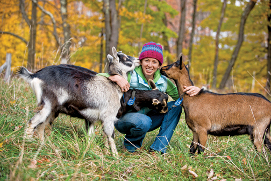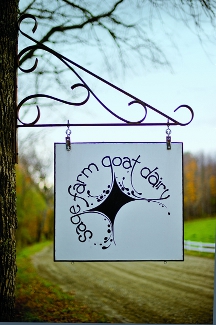The Right Whey
By Julie Flaherty
Molly Pindell, N05, took her own path to making scrumptious, sustainable goat cheese

Molly Pindell stops to play with the small herd of Alpine dairy goats she and her sister raise. They easily sell out of the goat cheese they make each week. Photo: Andy Duback
Molly Pindell’s handcrafted goat cheese is in high demand, be it the rounds of soft, light chèvre or truncated pyramids of creamy Sterling. Still, her father-in-law likes to tease her: Did she really need a master’s degree to become a goat farmer?
“Honestly, I didn’t,” says Pindell, who earned her degree from the Agriculture, Food and Environment Program in 2005. “But I do feel like a lot of what I learned in school has helped me to think big picture about the way I want my farm to be.”
Pindell and her sister, Katie, started Sage Farm Goat Dairy in Stowe, Vt., three years ago with the goal of making the farm as sustainable as they could. They move their small herd of Alpine dairy goats to fresh pasture on the 27-acre property each day. It’s a lot of work, but keeps parasites down naturally and is better for the soil.
Two enormous solar panels run the pasteurizer and most of their other electric needs. In the barn, layers of manure and hay compost throughout the winter, releasing heat that keeps the goats warm; in the spring, it becomes fertilizer for their two large vegetable gardens.
Staying local has been a calculated decision. They easily sell out the 60 to 70 pounds of cheese they produce each week, mostly through farmers’ markets. As a former professional chef who worked under the celebrated Jean-Georges Vongerichten in New York City, Pindell admits that the requests she gets from four-star restaurants and high-end cheese shops outside Vermont are tempting.
“There’s part of me that would be very excited about that,” she says. “But there is no way we would be able to satisfy all the demand we have. We’re not planning on becoming really big, ever. It’s very much a small, family operation.”
Farming wasn’t at the front of her mind when she enrolled at the Friedman School. She had her sights set on being a food journalist, a la Michael Pollan. Her longtime interests in writing, the environment and food politics came to a head while she was working as chef.
“Even in these fancy restaurants, people didn’t know where the food was coming from,” she says. “By and large the meat was from a big, nameless meat supplier, and to me it just felt very disconnected. I wanted to write about those issues.”
After graduation, she published several articles and columns, but a move to Boulder, Colo., so her husband could attend graduate school placed them very near a large goat dairy. She began working there, and soon fell for the cheese-making process.

Photo: Andy Duback
“I loved it. I just couldn’t get enough,” she says of both the cheese and the goats. “They are a lot like dogs. If they have the choice between staying with their herd and going out to pasture or playing with us, they’ll play with us. They are just really interesting, curious animals.” Plus, from a practical standpoint, she says, “they make wonderful milk, and their size makes them much easier to handle than cows.”
She plans to get back to writing one day, maybe when her children, Juliette, 3, and Soren, 1, are a little older, and maybe when her daily workload lightens. Because she currently handles all the cheese-making, and the milk doesn’t keep long, “even to leave the farm for one night is often impossible,” she says.
Although the work is very physical (mucking out the barn in the spring is the single most back-breaking day of the year), she often exercises her academic muscles, drawing on the lessons she learned about organic standards, farm regulation and the misuse of antibiotics. “We don’t treat our animals for anything unless we see a sign of ill health,” she says, unlike farms that give all their animals regular doses of medications to prevent illness.
Though the aim is to make delicious cheese, she says part of her job is to educate people about farming, which she can do both as a practitioner and as a scholar. Even her hard-won nutrition science skills come into play when customers ask her why goat cheese is easier for lactose-intolerant people to digest (the fat molecules are shorter) and if its lower saturated fat content makes it healthier than many cheeses (it does). “I feel well armed with knowledge,” she says.
This article first appeared in the Winter 2010 Tufts Nutrition magazine.
Julie Flaherty can be reached at julie.flaherty@tufts.edu.
